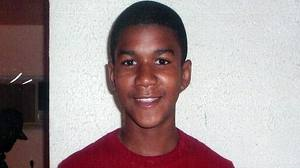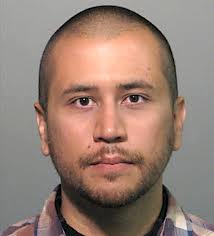“If I had a son, he’d look like Trayvon”: Troubling the Visual Optics of Race
Isabel Molina-Guzmán / University of Illinois Urbana-Champaign

On February 26, 2013, the one year anniversary of the shooting of Trayvon Martin in Sanford, FL by George Zimmerman, I stare at the beautiful face of Trayvon Martin on my television screen and online news feed. I study his cinnamon brown skin, big teddy bear brown eyes and long black lashes, trimmed tight curly black hair, well-sculpted nose and full lips. I hear the invisible and terrified cries for help, the shot, and the silence.
I am racially black and I am of Puerto Rican and Dominican ethnic descent. And I see my father, uncles, cousins. I silently remember President Barack Obama’s somber observation more than a year ago: “If I had a son, he’d look like Trayvon.”1
[youtube]http://www.youtube.com/watch?v=efZNgSEpB1k[/youtube]
The Problems with the Visual Optics of “Race”
I remember being frustrated by the news narratives that categorize Martin as black and George Zimmerman as white simply because of the color of their skin. After all, if Martin could be the son of our first mixed race president or be my son, his identity should be more complicated than the color of his skin. Martin’s gender, class, and ethnoracial complexities remain irrelevant – he was essentially, biologically, and categorically a black man. As a racial or ethnic identity, blackness remains static despite US Census reports that the black population is more racially and ethnically diverse that ever before with more than 25% of the growth among black Americans driven by immigration.2 Indeed Haitians are among Florida’s largest immigrant population.
Nevertheless, who is defined as black in the United States continues to be defined by the problematic rules of biological hypodescent – the one drop rule that defines anyone with one drop of “black blood” as black. How that “one drop” is often determined is by the visual resonances of blackness; and, Martin “looks” black.
Amidst civil rights protest calling for Martin’s murder to be classified as racial profiling and a hate crime, the story becomes more complicated and more troubling.
According to his father, Zimmerman is white and a minority too and my frustration increases: While images of protests from across the country skitter past on television screens, the elder Zimmerman has tried to do what others have been doing, in various ways, for days: define his son. George is “a Spanish-speaking minority,” the father wrote in a letter delivered to The Orlando Sentinel. “He would be the last to discriminate for any reason whatsoever.” George, the father insisted, was more like the boy he killed than people thought. George was a minority — the other — too.3 In other words, his father suggests that Zimmerman looks white but his mother’s Peruvian heritage means that he too understands racial discrimination and would never discriminate against another racial minority.
Shortly thereafter the news media correct themselves and finally and controversially Zimmerman becomes a “white Hispanic:” “Mr. Zimmerman, 28, a white Hispanic, told the police that he shot Trayvon in self-defense after an altercation. The teenager was walking home from a convenience store, where he bought iced tea and Skittles, when he was shot once in the chest.”4 However, Zimmerman’s newly found Latinidad remains unexplained and apparently journalistically insignificant despite his family’s attempt to inject his “ethnic brownness” into the public conversation as evidence of his racial innocence and the lack of Zimmerman’s racial motivation.

Conservative news commentators, such as this Washington Post columnist, angrily respond to the New York Times decision to qualify Zimmerman as a white Hispanic rather than simply a Latino or Hispanic: I guarantee you that if George Zimmerman did something good — if he finished first in his high school graduating class when he was younger — they wouldn’t refer to him as a white Hispanic, he’d just be a Hispanic. . . . He’s only a ‘white Hispanic’ because they need the word ‘white’ to further the story line, which is, White, probably racist vigilante shoots an unarmed black kid.5 Why aren’t Latina/o activist organizations, such as the National Council of La Raza, not outraged at the racial description of Zimmerman? Why are they not coming to Zimmerman’s defense Rush Limbaugh and others want to know?
Thanks to media narratives about the “browning of America,” Zimmerman it appears is too white or not brown enough to be read as Hispanic. The biologically driven visual optics of race that often write out white Latinas/os such as Cameron Diaz or black Latinas/os such as Rosario Dawson, fail Zimmerman’s attempt to racialize and shield himself from accusations of racism. Zimmerman does not fit the visual archetype of Latinidad.

In response to conservative criticism, the National Council of La Raza and other Latina/o political organizations point out the unspeakable by reminding us that Latinas/os and other minorities can be racists too. And the Congressional Hispanic Caucus joins other civil rights groups in calling for the Department of Justice to pursue Martin’s death as a hate crime.
Moving Beyond Visual/Biological Definitions of Race and Racism
On the anniversary of Martin’s death, I ponder how we might have arrived at this moment – when Latino racism remains un-interrogated, white Latina/o privilege unexamined, and blackness homogenized. How do we continue to live in a world where race is assumed to be visually and biologically definable and ethnicity invisible when it is not easily marked by race?
I am reminded of Silvio Torres-Saillant’s work regarding the ways US Latinas/os are socialized to negotiate racism by moving away from categories of race resulting in a breakdown of coalition building between Latinas/os and other US ethnoracial minority groups.6 I think about the ways in which ethnoracial minorities in the United States are often structurally positioned to compete for scarce resources – housing, food, low paying jobs. I reflect on Lisa Cacho’s notion of “racialized rightlessness” to recover the silent narratives of interracial violence and racism subtly embedded in the media’s coverage of the Martin case, narratives that position ethnoracial minority groups against one another; that implicitly suggest that one group is more deserving of rights than another group; that often ignore the ways all minority groups are denied social, political, and economic equality.7
I acknowledge my sense of loss. I have no answers. I finish this column and kiss my one-year old mixed-race, multi-ethnic son goodnight and whisper in his ear that it will be okay.
Image Credits:
1. Trayvon Martin
2. George Zimmerman
3. Antonio Banderas
Please feel free to comment.
- http://thecaucus.blogs.nytimes.com/2012/03/23/obama-makes-first-comments-on-trayvon-martin-shooting/ [↩]
- Benson, Janel. 2006. “Exploring the Racial Identities of Black Immigrants in the United States. Sociological Forum, 22 (2): 219-247. [↩]
- http://seattletimes.com/html/nationworld/2017819414_zimmerman23.html [↩]
- http://www.nytimes.com/2012/03/22/us/police-chief-draws-fire-in-trayvon-martin-shooting.html [↩]
- http://www.washingtonpost.com/blogs/erik-wemple/post/why-did-new-york-times-call-george-zimmerman-white-hispanic/2012/03/28/gIQAW6fngS_blog.html [↩]
- Torres-Saillant, Silvio. 2005. “Racism in the Americas and the Latino Scholar” in A. Dzidzienyo and S. Oboler (eds) Neither Enemies Nor Friends: Latinos, Blacks, and Afro-Latinos. Palgrave. [↩]
- Cacho, Lisa. 2012. Social Death: Racialized Rightlessness and the Criminalization of the Unprotected. NYU Press. [↩]
Pingback: Mixed Race Studies » Scholarly Perspectives on Mixed-Race » “If I had a son, he’d look like Trayvon”: Troubling the Visual Optics of Race
http://melungeon.ning.com/foru.....a-d-powell
The Lies that Sustain the Myth of “Passing for White”
When the “one drop myth” is reported in the mainstream media, no mention whatsoever is made of the evidence against it. Such evidence, if presented, never sees the light of day and is limited to a few people who take pains to study the subject. The American people are not allowed to consider the following:
* If the “one drop rule” is real and enforced by whites, why is a glaring exception made for Hispanics and Arab-Americans? It does not take a genius to see both the physical and historical evidence that Hispanics and Arabs are nearly all “tainted” with the blood of what used to be America’s official “inferior race.”
* Why aren’t Americans told that antebellum definitions of “white” tended to be more liberal than 20th century definitions; people with one-fourth to one-eighth Negro blood were legally allowed into the white race. For example, Edison Hemings Jefferson, the former slave son of Thomas Jefferson and Sally Hemings (and whose white descendants are the only Hemings descendants to pass a DNA test showing descent from the Jefferson line), was legally white once he was manumitted because the has at least seven-eights white. We should not be surprised that in both abolitionist and Republican Party literature, “white slaves” were frequently used to arouse the Northern white population against slavery. Why are these facts kept from the American people?
* What are the real world standards for saying that someone is “black” and not “white”? Edison Hemings Jefferson is always described in the media as “light-skinned black” who only “passed for white,” but his descendants are acknowledged as white without qualification. Where is the cutoff point? The only one I can see is that dead whites with a touch of the dreaded “tarbush” are “black” and those still living are ‘white.”
In the magazine American Heritage, a white woman named Jillian Sim announced that she had discovered that her great-grandmother was Anita Hemmings, a white mulatto or mixed white who graduated from Vassar College in the late 19th century was almost expelled for being “colored” when a wealthy and envious classmate decided to have her background investigated. Now Vassar proudly claims that Anita, who lived as white for the rest of her life, was their first “black” graduate. Jillian Sim accepts the myth that Anita was a “black” who “passed for white” and she condemns both her paternal grandmother and great-grandparents as “blacks” who “passed for white.” Sim, her father, and her son, however, are still white. The dead are “black” and the living are “white.”
After Broadway star Carol Channing’s recent disclosure that her father was partially black but lived all his life as a white man, you’ll notice that Channing is not described as “black” in the media but her father is described that way without qualification. Moreover, if you look at the Amazon.com comments on Channing’s autobiography, Just Lucky, I Guess, you’ll note that commentators who are black-identified insist on calling her “black” as well.
People as diverse as the actress Mae West, former U.S. President Dwight David Eisenhower and former Georgia Congressman Bob Barr, etc. have been labeled “black” (usually by blacks and black-identified mulattoes) on the basis of the one-drop myth. There appear to be no standards except opportunism – the ethnic rape charge again.
It is common, we at Interracial Voice have discovered, for black-identified supporters of the “one drop” myth to announce that people don’t “look white” when they’ve been white all or nearly all of their lives. They will shamelessly insist that Carol Channing doesn’t look white and Mae West didn’t look white. They could see the dreaded colored blood all along! Mixed whites who used to travel all over the Jim Crow South as white, are told by fanatical black-identified folks that they are obviously black. These rants are so similar, we swear there must be a school somewhere that teaches black-identified folks nothing but defense of the “one drop” myth.
“Passing for White” is an Honored American Tradition – for Nearly Everyone Else. “Passing” is an honored American custom – for nearly everyone except tarbrushed whites non-Hispanic, non-Arab whites and mulattoes who have the misfortune to be too American or Louisiana Creole. It is not so much your touch of the dreaded black blood that matters, but whether or not your ancestral documents (census records, birth, marriage and death certificates, etc.) bear the telltale words “mulatto” or “free person of color” or “Negro” on them.
The Latino Escape Hatch. Throughout most of the 20th century, Latino elites in the United States (and the government of Mexico itself) argued that all Hispanics should be classified as “white” on all official records – regardless of appearance or ancestry. So a blond person with the “tarbrush” could be labeled “Negro” in Texas while a dark-skinned Mexican with no white blood or European ancestry would be officially labeled “white” – even if he was treated more like a Negro than a white person. Now that is big time passing!
South Asians. Before the Civil Rights era and the rise of affirmative action, South Asians from India, Pakistan, etc. insisted that they were “white.” They were first labeled “nonwhite” and then received the ultimate honor of being called “white.” According to this myth, dark-skinned people from India were dark-skinned “Caucasians” while “tarbrushed” Americans of totally European phenotype were unworthy to call themselves “Caucasian.” Now South Asians are called “Asians” and are eligible for “minority” benefits and the numerous advantages “white guilt” can bestow. Big time passing!
Mississippi Chinese. The Chinese of Mississippi started out as “colored” and many of the men married “Negro” women. The leaders of the Chinese community begged the local white elites for the right to be classified as “white” instead of “colored.” The price the white elites imposed was rejection of all Chinese kin who were part-Negro or intermarried with Negroes. Big time passing and a rejection of family that you will never see condemned on television a la Imitation of Life.